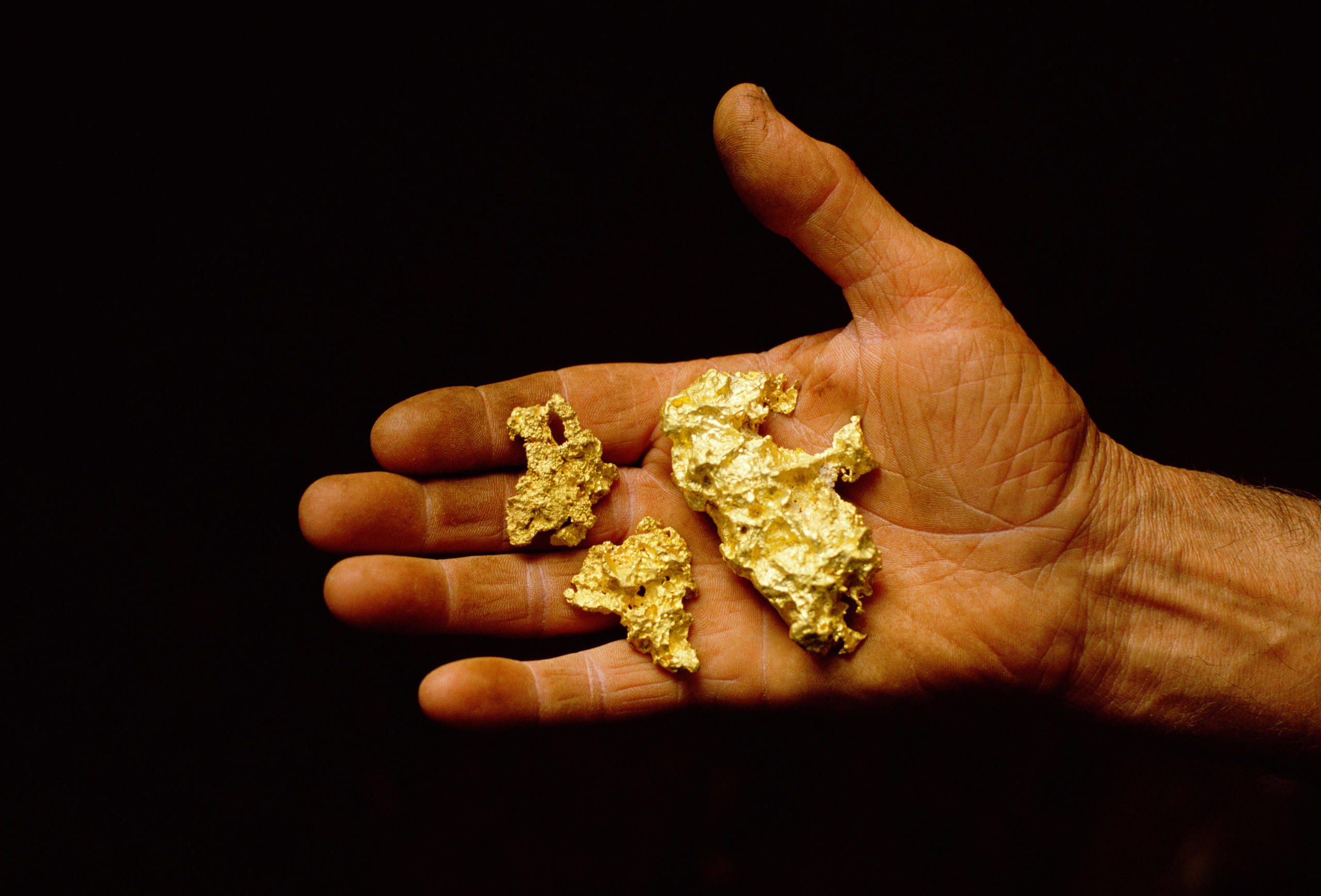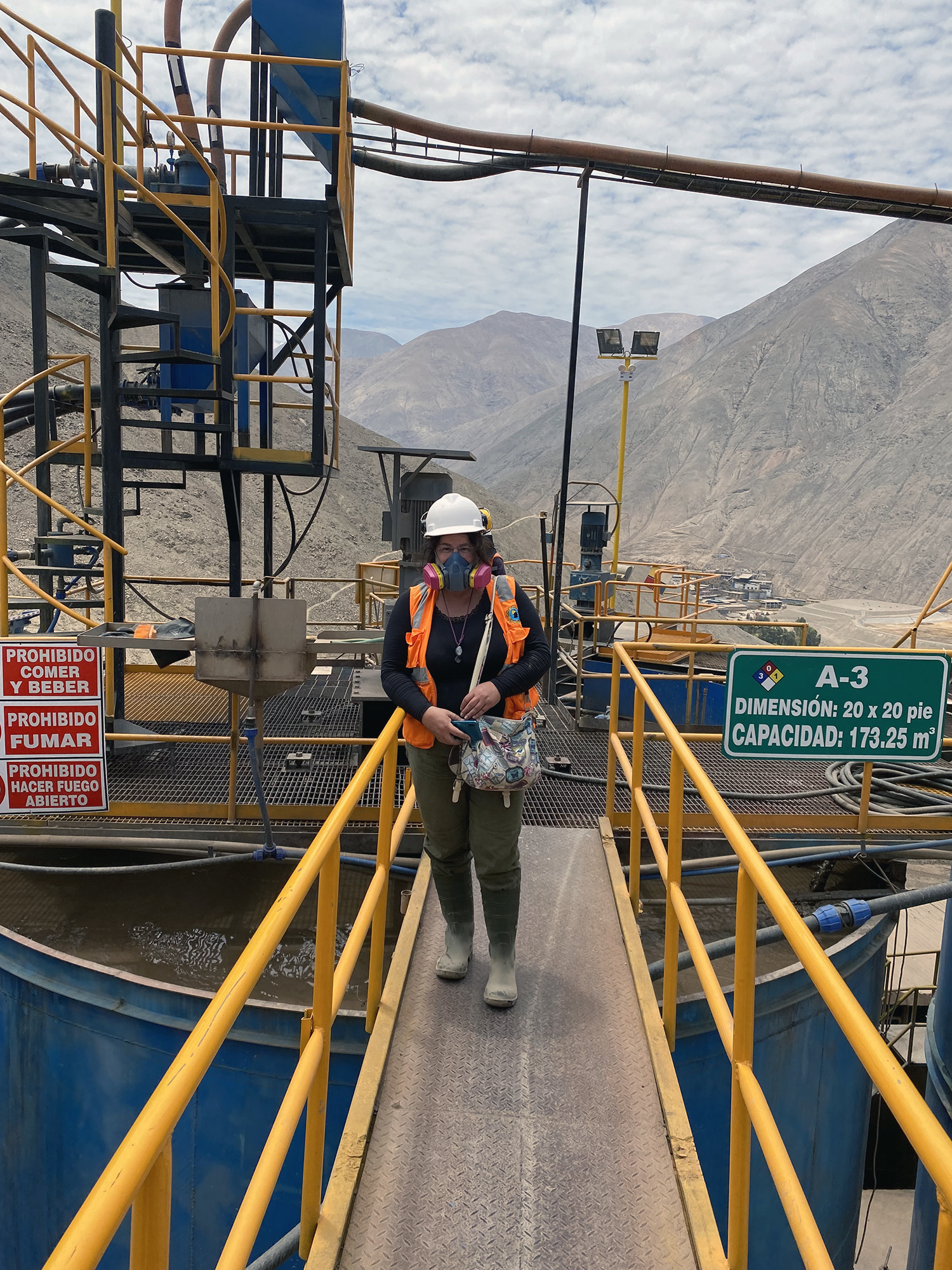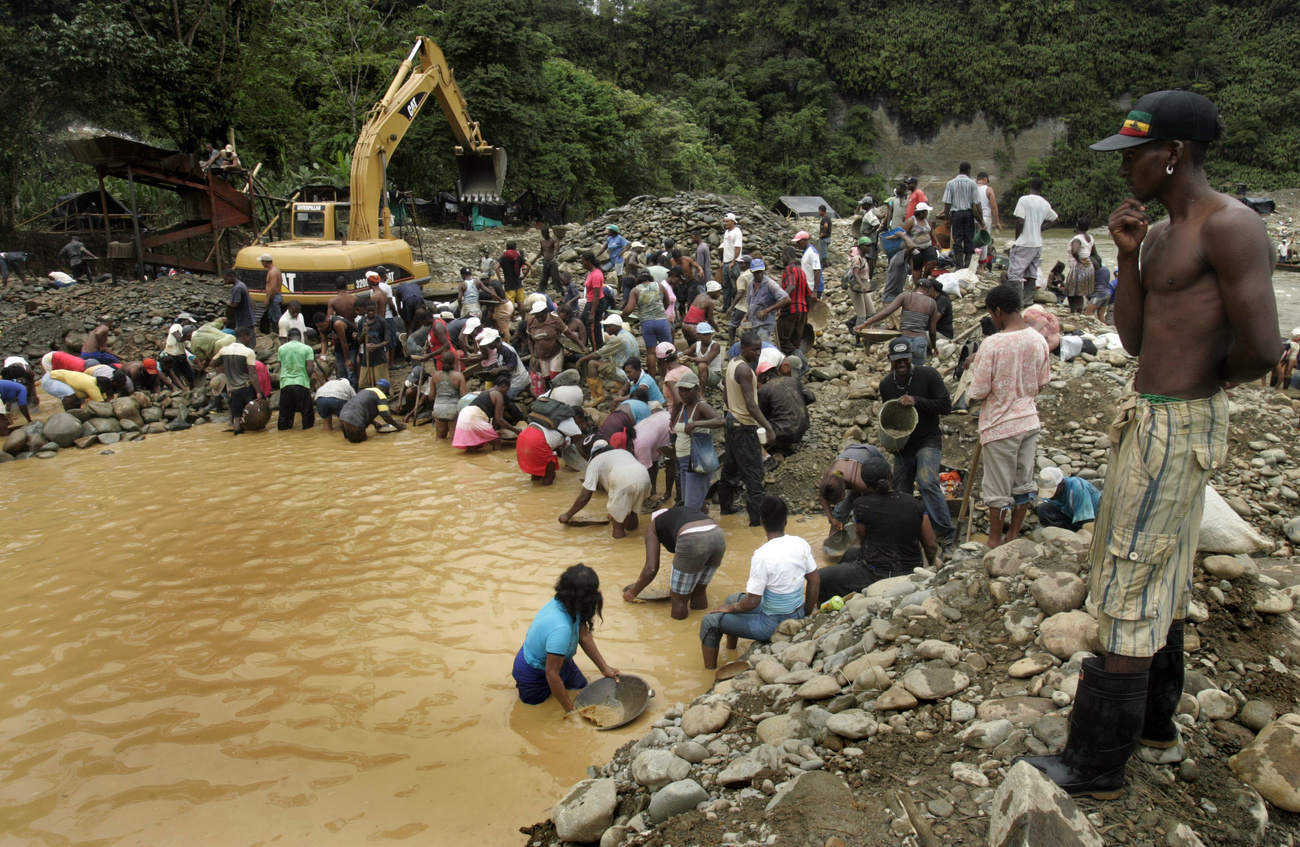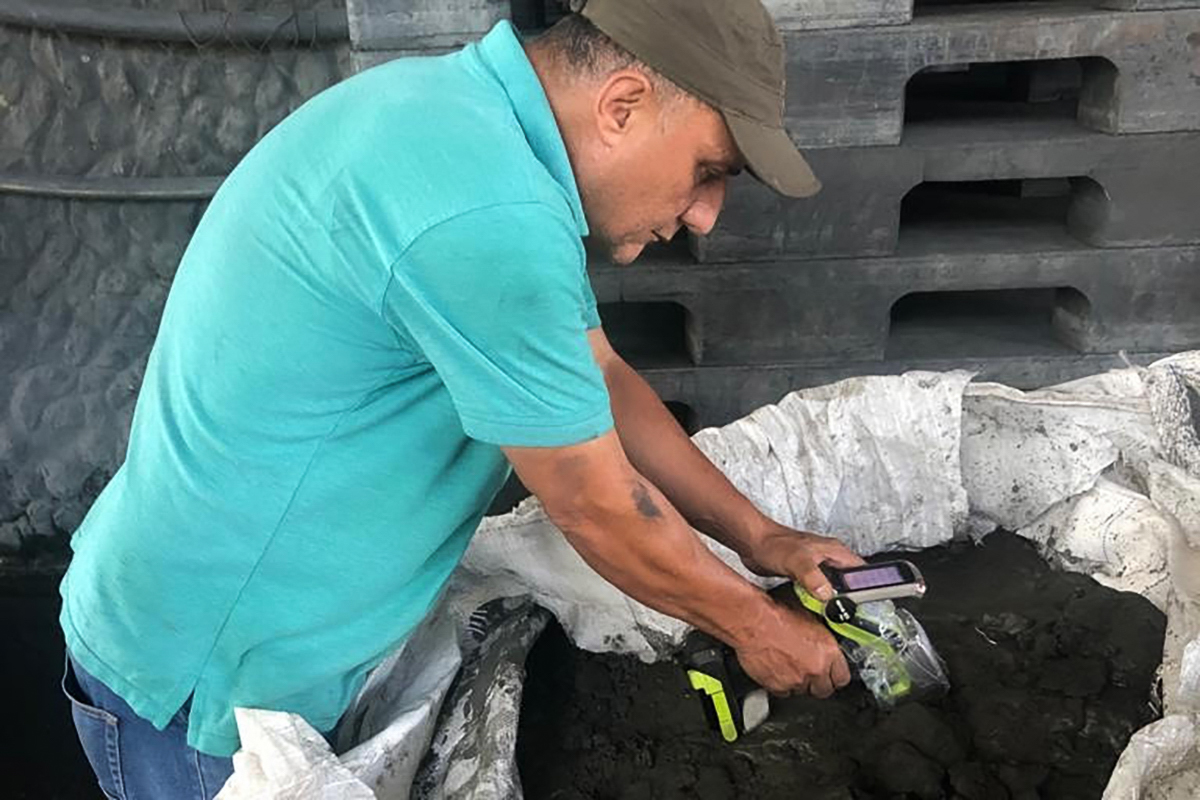
Fully traceable gold – technically feasible or pure fantasy?

It’s a noble quest yet one that’s so far proved elusive – tracing the precious yellow metal from its source in the depths of the Amazon forest and the peaks of the Andes to the refineries of Switzerland, where it’s turned into gold jewellery, watches and bars.
Scientific researchers and companies are in hot pursuit of technologies that can track gold’s journey to within metres of where it was mined, ensuring your rings and necklaces come from an African mine free of child labor or a licensed field in Brazil, rather than a pit unleashing toxic mercury or enriching criminal gangs in the Amazon.
“Switzerland has a special responsibility with respect to a reliable and fair gold supply chain,” environmental geophysics professor Niklas Linde told a conference on gold traceability at the University of Lausanne in May.
Gold is different from most other commodities traded out of Switzerland because it physically enters the country. About a third of the world’s mined gold and half of recycled gold is processed or refined within the borders of the Alpine nation, Linde noted.
Given its position as a top international gold refining and commodities trading hub, Switzerland is fertile ground for companies selling traceability technology.
+ From Nazis to refineries: how Switzerland handles the world’s gold
Multiple solutions
Digital and physical traceability technologies specific to precious metals are now on offer from a variety of players. The methods are compatible, so while tech companies might focus on selling the merits of one approach, refiners may use both.
For gold, the holy grail is achieving comprehensive traceability from the ground to the refined bar, regardless of whether the supply chain starts at a rudimentary artisanal operation or a large industrial mine. Blockchain solutions are popular but do not cover the entirety of the gold supply chain. Lausanne-based Sicpa , an old-timer in the traceability space, launched Bullion Protect this year – a security seal applied to a gold bar after the refining process.
The London Bullion Market Association and World Gold Council launched a joint pilot last year – the Gold Bar Integrity (GBI) programme – to digitally monitor gold’s journey from mine to vault. The programme has tapped two companies, including aXedras, a Swiss distributed ledger company based in commodity trading hub Zug, to develop a digital tracking solution using a blockchain-backed ledger. AlpVision, a Swiss-based provider of digital anti-counterfeiting technology, has also had its Fingerprint solution accredited by the GBI, allowing users to scan a product’s surface with a smartphone app to verify its authenticity.
Refineries, meanwhile, are wasting no time testing and developing technologies in-house. Switzerland-based refiner MKS Pamp developed its own blockchain-based traceability solution, Provenance, which it has been using since 2022 to trace precious metals and support its claims that it is sourcing gold responsibly.
Swiss refiner Argor-Heraeus uses a spray-on marker from Swiss traceability solutions developer Haelixa to track its gold from industrial mines in South America. That works in a well-controlled supply chain, but critics point out that the marker disappears if the gold is remelted.
Everyone wants to become the gold standard for traceability, and it’s a topic that generates heated debate.
Barbara Beck – the traceability guru
Geoscientist Barbara Beck was the brains behind the conference at the University of Lausanne that devoted two whole days to the issue – drawing the full spectrum of Swiss traceability companies and gold refiners, as well as law enforcement representatives from both Switzerland and Brazil. Gold traders, regulators, academics, and NGOs that focus on the environmental and human rights impact of gold mining and processing also attended.
A networking force of nature, Beck is passionate about the flow of metals across time and space. Her journey began with a PhD in archaeometry – which draws on scientific methods to resolve archaeological mysteries – and deep dives into topics such as silver production in Switzerland’s Wallis region in ancient times.

At the University of Lausanne, in partnership with Swiss refinery Metalor, Beck developed a scientific approach to validate the origin of doré, a bar made of precious metals including silver and gold, that is sent to refineries for further purification. The so-called Geoforensic passport, which was unveiled in May 2022, is now routinely used to test doré bars that arrive at Metalor’s refinery in Marin-Epagnier, in canton Neuchatel in western Switzerland. It identifies the chemical composition of the gold to confirm its source.
Other Swiss refiners have also taken interest in her method, which builds on existing processes for precious metal analysis used by refineries when they perform routine chemical testing of doré to assess its gold content.
Refiners “have to pay for the gold, pay the suppliers, and they need to know the gold content,” explains Beck. “It’s important to know whether a bar contains 50% or 90% gold.”
Refiners also test the doré for other elements that interest them – like silver and copper – as well as those that do not, deleterious elements such as selenium or arsenic that refiners don’t like because they are either toxic or more complicated to separate in the refining process.
As her method uses the analyses that are already done systematically on doré bars when they arrive at the refinery, there is no extra cost involved, she says. “What I can do with my software is determine right away whether this doré is consistent with other doré from the same supplier or not. When it does not conform, then the audits begin.”
Doré bars reflect the chemical composition of a mine [hence the notion of a geoforensic passport]. This allows Beck to distinguish one doré from another by performing a chemical analysis. The method also allows analysis of changes over time. “A doré that comes from a mine two years ago does not have the same signature as a doré today,” notes Beck. “You see an evolution over time in the chemical composition.”

Starting at the mine
Another solution focusing on the most challenging stretch of the supply chain was developed by Zurich-based GeoBlock, a data management company specialising in upstream gold production analytics. Its co-founder, entrepreneur Bruno Regli, has worked in the gold sector since 2009, initially with a focus on mining operations in Colombia. In 2019, he began looking for a solution to provide traceability that starts at the mine, drawing on tests that he conducted at his gold mine in Colombia and others in his network.
“We started with gold because we think there is a demand from the banks and the refiners to really know the origin,” says Regli.

In the old days, he explains, gold miners would use a spectrometer to read copper, silver, and gold. Today there are next generation spectrometers with a CHF50,000 price tag that allow for richer analysis. GeoBlock’s traceability solution combines analysis of metal elements with statistical calculations to verify that gold originates in a specific geography.
“Geology is different all over the world,” he explains. “We analyse all possible elements, often around 40. The machine-learning algorithm tells me which ones are the most significant for testing and which ones follow through the whole supply chain: from the extraction until the doré or to the refinery.” The analysis allows him to verify that a metal comes from a particular area.
How precise is the technology? “On the tests we did in Colombia, we could already see differences between [gold] veins that are 500 to 800 metres apart, location wise,” Regli says.
Ultimately, though, it boils down to probability. “We can tell the refiner this material is coming from this area,” he says. “Obviously we cannot tell you if it is coming from the left-hand side or the right-hand side of the river. If the geology is totally different, you can even see it with your own eyes. In fact, usually, with proper visualization, it’s obvious without a statistical test whether material is fake or not.”
A few kilometres – or just a few hundred metres – can mean the difference between a legal and illegal mine, a distinction that is one of the biggest headaches of the gold supply chain in Brazil, one of South America’s major producers.
An Amazon-sized problem
In 2021, Switzerland was the largest buyer of Brazilian gold ($1.26B), just behind Canada, according to the Observatory of Economic Complexity.
But mining in the Amazon region is having a deleterious impact on the land and local indigenous populations. The environment is being polluted due to the use of mercury to extract the precious metal through the process of amalgamation, deforestation is destroying natural habitats, and organised crime is pervasive across the value chain.
Stretching across nine countries, the vast Amazon rainforest accounts for one third of the world’s tropical forests, which are vital for the health of the planet. “Illegal gold mining kills and threatens indigenous peoples, it threatens our forests and therefore threatens our future,” Raul Jungmann, president of the Brazilian Mining Association (IBRAM) and a former minister, told the conference in Lausanne.
In 2022 Swiss refiners pledged not to take gold from the Amazon but this is a difficult promise to keep. Efforts at due diligence have been complicated by the sheer size of the rainforest and a “good faith” approach to sourcing – declarations by gold sellers of where the gold was mined are accepted at face value.
Between 2015 and 2020, Brazil traded 229 tons of gold that showed evidence of illegality, according to a study by the Sao Paulo-based sustainability organisation Instituto Escolhas. The majority of the gold traded by Brazil in 2021 (52.8 tonnes or 54% of national production) may have been illegal, according to the same source. Deforestation was rampant under former president Jair Bolsonaro.

A change in government in Brazil this year has ushered in tighter controls on the gold trade and pushed environmental and indigenous concerns up the national agenda. The Gold Provisional Measure, adopted in April, ended good faith sales and mandated electronic invoices for buying, selling, and transporting gold within the country.
Brazilian gold trader Andrei Santos, who exports 250 to 300 kilos of gold per month to Switzerland, has doubts about the effectiveness of physical traceability solutions, based on personal experience. “Regionally, I think the idea [of a gold DNA] is beautiful,” he says. “You cannot get gold from let’s say Cuiabá and have the same gold characteristics as gold produced in Venezuela. But for me, that does not guarantee where the gold is actually from.”
Cuiabá is the capital city of the Brazilian state of Mato Grosso, which is part of the Amazon region and where his office is based. In one instance, DNA analysis led him to incorrectly conclude that one of his suppliers was smuggling gold from another region. The usual output of this gold producer was 92%-97% gold with few contaminants. But one day the gold produced had different properties: 85% gold, 5% led, 3% iron and some silver.
So he took a team to the site to investigate. “I stayed there the entire day, I saw the gold being produced,” says Santos, one of MKS Pamp’s suppliers. “Long story short, I was wrong. Why? Because it is nature. It is not that precise… Gold is not a mathematical equation.”
Achieving compliance and peace of mind takes many resources and steps, he says. His compliance department accounts for 40 of the 85 people in his office, and he uses a software programme to flag irregularities. A red light might flash if a mine, typically producing five kilos per month, suddenly sells 15 kilos to the company in one month. A separate company sends geologists to mining sites with GoPro cameras, much like police officers, to carry out checks.
“All our mines are under this constant process of monitoring,” he says. “What I want inside my company is 100% traceability… What DNA, what traceability solution can guarantee to me [that the gold] did not come to me from that [illegal] area? It’s not that precise. It is not spot on.”
Traceability vs. transparency
Back in Switzerland, refiners stress the distinction between transparency and traceability. They say it is possible to have a traceable supply chain without necessarily being transparent about everything, arguing that revealing their sources would compromise their competitiveness.
At the conference in Lausanne, the CEO of one Switzerland-based refinery proposed that refineries should communicate with the public about the systems and technologies in place but not share their actual data. “We should not reveal our sources, but we should communicate about the systems we have in place to ensure that the sources we have are clean,” he said during a focus group discussion.
Those in law enforcement take a different perspective and see traceability solutions as key to supporting their work. “What is important for us is to be sure that the data is confirmed, is a mirror of reality,” said Sylvie Bertrand, the public prosecutor for Geneva, a major hub for Swiss gold traders, during another panel discussion.
It is also important for law enforcement officials to have the tools that enable them to read and process the data, and then use it to confront their partners and those suspected of illegal activity, she added. At the end of the day, a court needs to be able to understand the data when presented with a case.
Traceability is key for regulators as it allows them to link all the necessary details, said Thomas Brodmann, head of the central office for Precious Metals Controls, which enforces Swiss regulation on gold.
“You must be able to link the gold from that Amazon region to that exact refinery,” he told the panel at the Lausanne conference on the feasibility of institutionalising traceability. “If it doesn’t go directly from Brazil to Switzerland but goes through several different countries, and it is melted together, then it becomes very difficult, almost impossible [to make those linkages]. That is the situation today.”
PLACEHOLDERMore

In compliance with the JTI standards
More: SWI swissinfo.ch certified by the Journalism Trust Initiative

































You can find an overview of ongoing debates with our journalists here . Please join us!
If you want to start a conversation about a topic raised in this article or want to report factual errors, email us at english@swissinfo.ch.